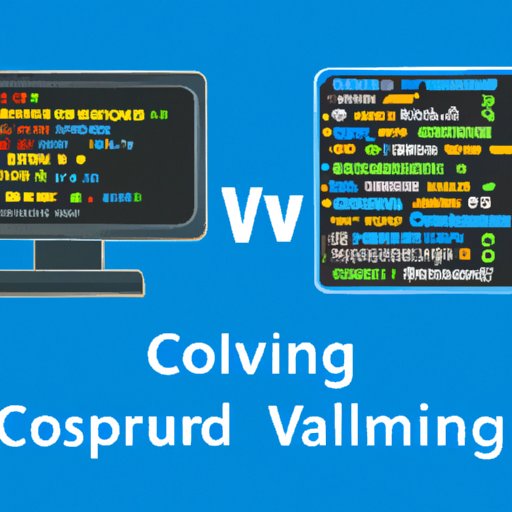Introduction
Computer programming is a skill that can open up a world of possibilities. It involves writing code to create software, applications, and websites. By learning how to program, you can become an invaluable asset to any organization or company. But where do you start? This article will explore what basic computer programming is and provide a comprehensive guide for beginners.
Beginner’s Guide to Computer Programming: An Overview of the Basics
A foundational understanding of computer programming is necessary before diving into more complex topics. Here, we’ll explore the basics of computer programming and key concepts.
What are Variables and Operators?
Variables are containers for storing data values. They are used to store information such as numbers, words, and characters. Operators are symbols used in programming to manipulate variables. For example, the plus sign (+) is an operator used to add two numbers together. There are various types of operators, such as arithmetic, comparison, and logical operators.
How Do Computers Execute Code?
When computers execute code, they go through a series of steps. First, the computer reads the code line by line. After each line is read, the computer checks for syntax errors. If there are no errors, the computer then interprets the code and executes it. Finally, the computer displays the results of the code.
Key Concepts in Computer Programming
In order to effectively write code, it’s important to understand certain key concepts. These include control flow, data structures, and algorithms. Control flow refers to how the code is structured and how it flows from one step to the next. Data structures are used to organize and store data so it can be easily accessed and manipulated. Algorithms are sets of instructions used to solve problems.

Exploring the Different Types of Computer Programming Languages
Computer programming languages are used to write code. Different languages have their own set of rules and syntax. Some languages are better suited for certain tasks than others. Let’s take a look at some of the most popular programming languages and their pros and cons.
Popular Programming Languages
The three most popular programming languages are Java, Python, and C++. Java is an object-oriented language used for developing web applications. Python is a general-purpose language used for scripting, automation, and data analysis. C++ is a powerful language used for game development and system programming.
Pros and Cons of Each Language
Each language has its own unique advantages and disadvantages. Java is easy to learn and has a large community of developers who can provide support. However, it has a slower execution time than other languages. Python is versatile and excellent for rapid prototyping, but can be slow for certain tasks. C++ is fast and efficient, but it can be difficult to learn due to its complexity.
What Are the Benefits of Learning Computer Programming?
Learning computer programming can offer many benefits, both personally and professionally. Here are just a few.
Career Opportunities
Having knowledge in computer programming can open up a variety of career opportunities. Programmers are in high demand in the tech industry and can find work in almost any field. From software engineering to game design, there is no shortage of job openings available for those with programming skills.
Problem-Solving Skills
Programming requires problem-solving skills. As you write code, you must think logically and creatively to come up with solutions to complex problems. Developing these skills can help you in other areas of life as well.
Increased Creativity
Writing code allows you to express your creativity in unique ways. You can use your imagination to create something new and innovative. Plus, the satisfaction of seeing your code come to life is incredibly rewarding.

Common Computer Programming Mistakes and How to Avoid Them
When learning to program, it’s important to recognize and avoid common mistakes. Here are some of the most common errors and tips on how to avoid them.
Syntax Errors
Syntax errors occur when the code is written incorrectly. To avoid this type of error, make sure to pay close attention to the syntax of the language you’re using. Also, use a code editor with features such as syntax highlighting and code completion to help detect potential mistakes.
Logic Errors
Logic errors occur when the code is written correctly, but it produces the wrong output. To avoid this type of error, double check your code and make sure it’s doing what you intended it to do. Additionally, use debugging tools such as breakpoints and print statements to help identify logic errors.
Debugging Techniques
Debugging is the process of finding and fixing errors in code. When debugging, it’s helpful to have a systematic approach. Start by isolating the issue and then use the debugging tools mentioned above to help identify and fix the error. Lastly, test the code to ensure it works properly.
Tips for Teaching Yourself Computer Programming
Teaching yourself computer programming can seem daunting, but it doesn’t have to be. Here are some tips to help you get started.
Find a Course or Tutorial
There are plenty of online courses and tutorials available to help you learn programming. Find one that fits your needs and interests, then dedicate some time to studying it. Make sure the course or tutorial you choose is up to date and uses the latest version of the language.
Start with Simple Projects
Don’t try to tackle a complex project right away. Start with something simple and work your way up. This will help you build confidence and gain experience in programming.
Practice Regularly
Practice makes perfect. The more you practice, the better you’ll become. Dedicate some time each day to writing code and experimenting with different concepts. This will help you retain the information and solidify your understanding of the language.
Conclusion
Computer programming is a valuable skill that can open up a world of possibilities. This article explored what basic computer programming is and provided a comprehensive guide for beginners. We looked at variables, operators, different programming languages, and the benefits of learning computer programming. We also discussed common mistakes and tips for teaching yourself. With dedication and practice, anyone can become a proficient programmer.
(Note: Is this article not meeting your expectations? Do you have knowledge or insights to share? Unlock new opportunities and expand your reach by joining our authors team. Click Registration to join us and share your expertise with our readers.)
